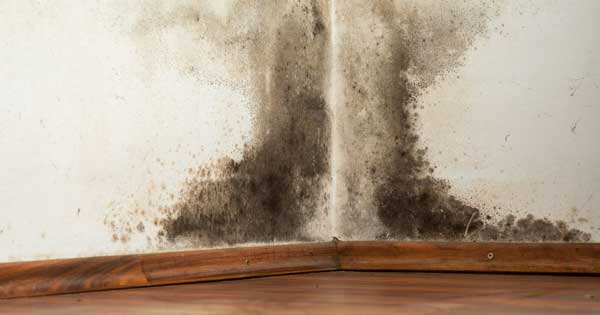1. Penetrating damp happens when there’s a problem with the fabric of the building. While the damp usually moves horizontally from the outside in, it can appear on ceilings (see below) as well as walls. Defective or missing flashing on the roof, defective or blocked guttering, defective pointing and brickwork, and cracked or missing render typically cause penetrating damp, although there may be other causes. Sometimes what appears to be damp may actually be condensation.
2. If the lower part of a wall is damp, it’s probably rising damp (water coming up from the ground), in which case the solution may be a new damp-proof course, installed by a specialist damp company (other damp-proofing solutions are available). Once the bricks are damp, the moisture usually transfers to the plaster inside – tell-tale signs include dark patches and blistering/bubbling paint, but it’s not always obvious that the plaster is damp. Damp plaster should be removed to expose the bricks underneath – letting them dry out is a good idea, but it can take a very long time.
3. If you can’t wait, get a plasterer to do a waterproof render and then replaster, so there’s a barrier between the moisture in the bricks and the new plaster. This is a messy process and if you get a specialist damp company to do it, it may be expensive, but they should provide a guarantee. Most plasterers won’t give you a guarantee, but should charge a lot less. The key is to get an experienced and reputable plasterer who knows what they’re doing and uses the right products. If the waterproof render isn’t done correctly, the damp will come back through the plaster, which is disastrous.
4. Sometimes the damp-proof course is simply being prevented from doing its job. You should be able to see it along your home’s exterior walls – look for a row of small holes a little way up from the ground. In old properties, slate was used as the original damp-proof course and is sometimes still in place. If the level of your garden, patio or path is higher than the damp-proof course, for example, it won’t work properly.
5. Perhaps you’ve noticed damp on a chimney breast, or where the chimney breast would have originally been? This could be because the chimney stack needs repairs, the chimney pot isn’t capped, or the chimney breast isn’t ventilated properly indoors. When a fireplace opening is sealed up, a vent should be fitted, but isn’t always (it’s a relatively straightforward DIY job to fit one), and vents can get blocked with dust and debris. A defective chimney or roof can cause damp on the ceilings below, especially if there’s no roofing felt, which is sometimes the case in old properties.
How-to tip
The quickest and easiest DIY way to deal with damp plaster is to cover it with anti-damp paint and then repaint the topcoat. Anti-damp paint is usually really thick, so apply it with a brush (to get lots on) and then use a mini foam roller to get a good, flat finish. Leave it to dry thoroughly – see the manufacturer’s instructions – and apply a second coat if recommended. Anti-damp paint works well for a while, but, in my experience, is rarely able to hold back damp long term.
